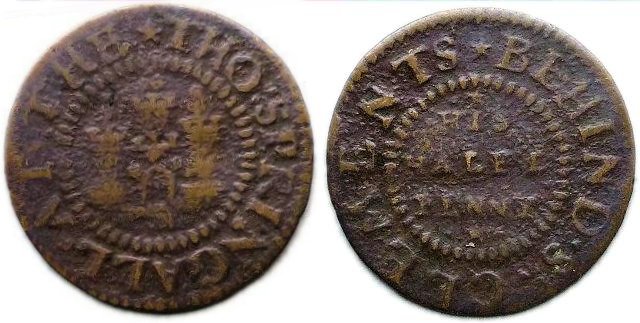
A half penny token of Thomas Springall of the Castle Tavern, behind St. Clement Danes Church, Westminster
The above copper half penny token measures 19.2 mm and weighs 1.27 grams. It was issued by Thomas Springall a vintner who operated from premises behind St. Clement Danes church in the Savoy Ward of the Westminster.
The design of the token may be formally described as follows;
Obverse: (mullet) THOS. SPRINGALL . AT. THE , around a beaded circle, within the depiction of a castle comprising gateway with portcullis supported by two towers with conical caps and a similar central tower behind.
Reverse: (mullet) BEHIND . ST. CLEMENTS, around a beaded circle, within the legend in three lines HIS / HALFE / PENNY with a mullet above and below.
The token is undated but on stylistic grounds probably dates from the mid to second half of the 1660s.
Based on the obverse design of Thomas Springall’s token it is almost certain that he was the proprietor of the Castle Tavern. A tavern of this name is known to have been located in the vicinity of St. Clement Danes based on earlier numismatic evidence. A total of three separate farthings plus a half penny token, all evidently commissioned by the same landlord, were issued in the name of the Castle Tavern between c.1655 to c.1663 (Note 1). These earlier tokens variously state the location of the Castle Tavern as either “Behind” or in the “Churchyard” of St. Clement Danes. A review of the Hearth Tax returns for 1666 indicates that a Thomas Springall, of the Savoy Ward of Westminster, was paying tax on a property with 17 hearths. This would be typical of a good-sized London tavern of the period. Thomas was paying tax on the second highest number of hearths listed for any single person in the Ward except for a handful of well to do inhabitants who were obviously living in very palatial residences.
Based on the partial addresses given for the Castle Tavern on the various tokens mentioned above, coupled with its obvious substantial size (as indicated by its large number of hearths) it is possible to hazard a guess as to its precise location. A review of John Ogilby and William Morgan’s 1676 map of London indicates one particularly large building located on the “Backside of St. Clements” adjacent to the north-west part of the parish churchyard. It is tempting to associate this building with that of the Castle Tavern.
Other than for the five separate token issues struck in the name of the Castle very little is known about this particular London tavern. In his diary entry for 21st November 1667 Samuel Pepys, the famous Diarist and Naval Administrator, records the following which may well be a direct reference to the Castle Tavern although he does not mention it by name;
“I out and took coach to Arundell House, where the meeting of Gresham College was broke up; but there meeting Creed, I with him to the taverne in St. Clement’s Churchyard, where was Deane Wilkins, Dr. Whistler, Dr. Floyd, a divine admitted, I perceive, this day, and other brave men.”
Interestingly on four earlier occasions in 1667(Note 2) Pepys visited a tavern in the Savoy Ward of Westminster which he referred to by name as the “Castle”. He also refers to this establishment as being “hard by Exeter House”; “by Exeter House” or “by the Savoy”.
26th Jan 1666/7 – I in my Lord Bruncker’s coach, he carried me to the Savoy, and there we parted. I to the Castle Tavern, where was and did come all our company, Sir W. Batten, [Sir] W. Pen, [Sir] R. Ford, and our Counsel Sir Ellis Layton, Walt Walker, Dr. Budd, Mr. Holder, and several others, and here we had a bad dinner of our preparing, and did discourse something of our business of our prizes, which was the work of the day.”
26th March 1667 – “…to Exeter House, where the judge was sitting, and after several little causes comes on ours, and while the several depositions and papers were at large reading (which they call the preparatory), and being cold by being forced to sit with my hat off close to a window in the Hall, Sir W. Pen and I to the Castle Tavern hard by and got a lobster, and he and I staid and eat it, and drank good wine;
27th March 1667 – “By water to the Castle Taverne, by Exeter House, and there met Sir W. Batten, [Sir] W. Pen, and several others, among the rest Sir Ellis Layton, who do apply himself to discourse with me…”
23th August 1667 – “So being all dusty, we put into the Castle tavern, by the Savoy, and there brushed ourselves, and then to White Hall with our fellows to attend the Council, by order upon some proposition of my Lord Anglesey, we were called in.”
It appears odd that the last four diaries entries quoted refers to the Castle Tavern by name and close by the Savoy and Exeter House while the entry later in the year (i.e. 21st November) just refers to a tavern, without name, in St. Clements Churchyard. Are all five entries a reference to the same establishment or were there two Castle taverns in close proximity in the Savoy Ward of Westminster? On first examination such a prospect might seem unlikely. However, by reviewing the evidence preserved in the numismatic record there would appear significant grounds to suggest the existence of two taverns by the name of the Castle in the area.
A farthing token exists (Note 2) in the name of a John Peek, a cook trading at or by the sign of the Castle “Against Ye Savoy” (Note 3). Thus we have clear evidence of a “Castle” adjacent to the Savoy and Exeter House plus a further one “Behind” or in the “Churchyard” of St. Clement Danes. So it does appear that there was two “Castles Taverns” in relatively close proximity to each other.
Returning now to the subject of the above half penny token’s issuer. Thomas Springall was born on 6th March 1638. He was the youngest of five children (John b.1626, George b.1630, Edmund b.1633, Katherine 1635) born to Edmund and Katherine Springall of Petworth, Sussex. His father is variously described as a yeoman and later a tailor. Thomas was apprenticed by his father to Richard Frewen, vintner of London, on 7th October 1651(1). By becoming an apprentice vintner Thomas was following in his brother Edmund’s footsteps. Edmund, was apprenticed to William Beswick (a London vintner) in 1647. There is no evidence to suggest that Thomas Springall ever took on any apprentices of his own.
It is assumed that Thomas Springall served a standard seven years apprenticeship under Richard Frewen before receiving his freedom (c.1658). Thereafter he presumably started out on his own career as a vintner. It may have been shortly after this time that Thomas took over the running of the Castle Tavern behind St. Clement Danes church.
A search of London parish registers has failed to identify any evidence of Thomas Springall’s marriage or the baptism records of any possible children he may have had. His single status is further backed up by obvious omissions to a spouse or children in his Will (date 5th September 1668)(2) and the fact that his half penny token gives no indication that he was married. It was often the case, particularly on the earlier farthing token struck in the mid-17th century, that if a token issuer was married he would often display both his and his wife’s initials in the form of a triad on the reverse of his token. This practice continued on some of the normally later issued half penny tokens of the 1660s.
Thomas made his sister Katherine’s husband, Francis Snell, the executor of his Will in which he made the following bequests and provisions;
To his widowed mother, Katherine Springall the sum of £6 to be paid in quarterly instalments.
To his brother George the sum of £5.
To Mary Challoner, his maid servant, the sum of 40 shillings.
The provision of 20 shillings to each of the following for the purchase mourning rings (Note 4) ; William Collins, Henry Maurice, Daniel Bell plus his sister Katherine and her husband Francis Snell.
The rest of Thomas’ goods and estate (after the deduction of funeral costs) were to be left to his brother-in-law Francis Snell’s eldest son, who was also named Francis.
It is possible that at the time of preparing his Will that Thomas Springall knew he was dying as a month later on 9th October 1668 his burial is recorded in the parish register of St. Clement Danes.
Notes:
1) One of three farthings and a half penny token issued in the names of Mr. J.P. alone or in association with one of his two wives (i.e. Mrs. J.P. and Mrs. A.P.) from the Castle tavern which is variously stated on the tokens to be either “Behind St. Clements”, “In St. Clement Danes” or in “St. Clement Churchyard”.
2) The farthing token of John Peek, a cook, who presumably traded from premises at or by the sign of the Castle against the Savoy Hospital, Westminster.
3) The reference to the “Savoy” in this instance is to the Savoy Hospital which was a principal waterfront landmark which gave its name to this particular Ward of Westminster. The Savoy Hospital was built by Henry VII on the site of the old Savoy Palace which had been largely destroyed by Watt Tyler’s followers during the Peasant’s Revolt of 1377. The hospital, for the poor and needy, opened in 1512.The grand structure was the most impressive hospital of its time in the country and the first to benefit from permanent medical staff. It closed in 1702 and in the 19th century the old hospital buildings were demolished.
The only part of the hospital complex to survive the demolition works of the 19th century was the Savoy Chapel. Originally dedicated to St. John the Baptist the chapel served as home to the congregation of St. Mary-le-Strand. The memory of the Savoy is today retained in the names of the famous Savoy Hotel and the Savoy Theatre along with several other local buildings which now stand on or close to its original site.
4) The presentation of mourning or funerary memorial rings was common practice in the 17th and 18th centuries particularly amongst the middle and upper classes. Many wealthy people included instructions in their will on how much money was to be set aside for the purchase and inscribing of funerary rings together with instructions as to their design plus a list of those people who were to receive them.
In Samuel Pepys’s Will he bequeathed the grand total of 129 mourning rings be given away at his funeral. The grander and number of rings bequeathed by an individual was often an indication of their wealth. The internal shanks of such rings were often inscribed with the name of the deceased as a memorial. The designs of such rings were often “ghoulish” by modern standards and typically included skulls and cross-bones or simply a skull (i.e. the so-called deaths head design).
References:
-
Webb, C. – London Livery Company Apprenticeship Registers. Volume 43. Vintners’ Company 1609-1800. (2006).
-
PROB/11/328. National Archives (London).

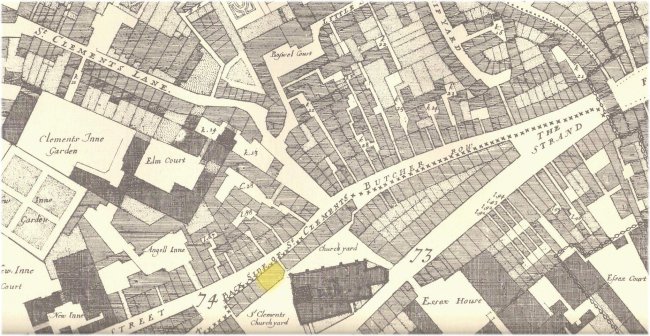
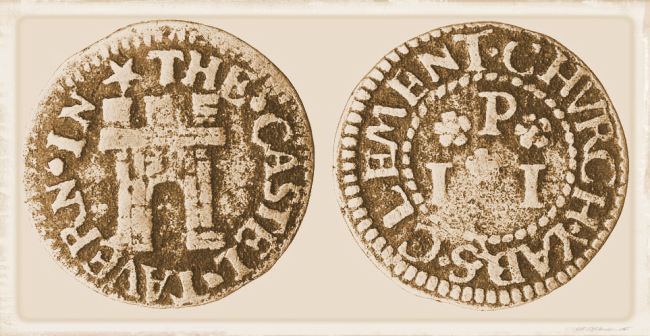
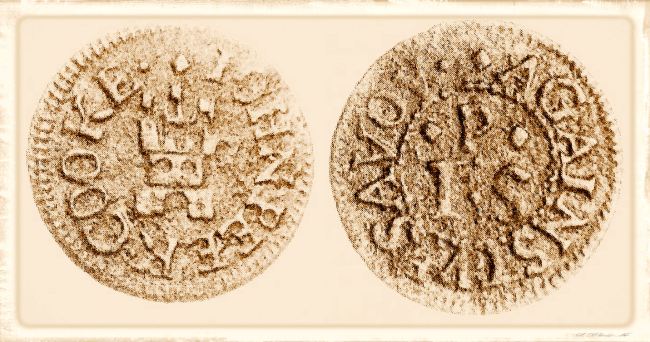
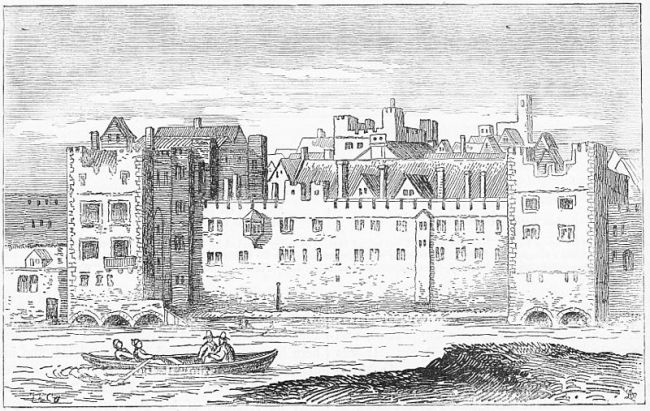
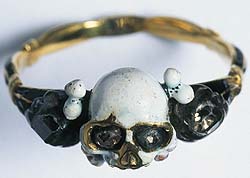
Thanks for shaaring
LikeLike